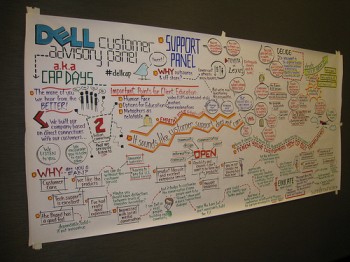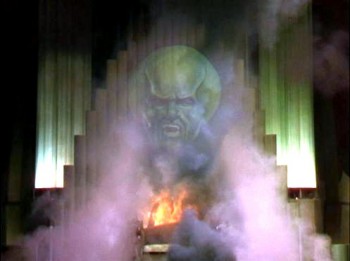Fodder to Focus

Wed through Friday last week I was honored to be part of the inaugural DELL Customer Advisory Panel (CAP) event at the DELL HQ in Round Rock, TX. (Thank you, DELL, for generously covering the costs of our travel.) I arrived with curiosity about the experience fueled by the information sharing that introduced the event.
Now I’m home and my mind is filled with the experience — so much “fodder.” This is a case study in a new sort of customer outreach. It was participatory anthropology. The people studying our responses were in the room asking questions, adding thoughts, and most importantly, listening and hearing.
This was NOT a focus group.
What Impressed Me
This was the first #DellCAP event.
Here’s a little about the event that impressed me:
- Two groups attended each on a different day. The fifteen invitees on Tuesday were people who might be considered DELL critics. Some in that group told me they didn’t see themselves as anti-DELL. The fifteen invitees on Thursday were people who might be considered DELL evangelists. Some in that group said they didn’t see themselves as particular pro-DELL either. The idea that DELL invited people they saw as both ends of the spectrum impressed me.
- The morning sessions included C-Suite and senior executives. DELL interest in the event was high. The room had an audience and folks outside the room could “dial in.” DELL considered the event a valuable experience. Conversation with people at every level of the organization proved their excitement to be learning from outside sources what they need to change.
- The breaks and side interviews showed DELL employees interested in extending the conversation and forming relationships that went beyond the day that we were there.
- The tenor and the tone of the morning conversations, especially that around customer service was particularly open and centered on learning. The people who work with the outsourced and overseas help talked frankly about their goals and their focus on price. Their ownership of policy problems led to some great discussion that went beyond service to strategic positioning — ideas that could bring the awesome DELL of the past back to us.
What Might Have Worked Better
The afternoon was in the DELL Labs and took the form of a presentation. Personally I see some ways that it might have invited more interaction to pull more value from the event.
- The product presentation about the specialists and generalists DELL serves was enlightening. It might have been fun to ask the invitees which group most described them and invite the larger group split off to explore more deeply the products designed for them. A chance to discuss one product line might have triggered a more invested discussion than a survey view of the whole product offering. Smaller groups might have offered a refreshing change in the day and a chance to see who’s most like us.
- The upcoming new product (NDA session) naturally had to be a “talk at us” session. At this stage, our input is moot. It’s nice to get insider information, but it might have been more exciting if DELL had said, “If you’re interested, we’ll send you more information right before the release it so that you can play with it and be the first to share news about it, if you choose.”
- The session on sustainability and recycling was also Web 1.0. Imagine how engaging it might have been if DELL had shared what they’re doing; then invited us to brainstorm ideas on how they might use social media to spread the news about the worldwide efforts on http://www.dell.com/recycle/ I had no idea they have so many sustainability partnerships going on.
Information to Strategy?
I can only imagine the wealth of ideas and information compiled throughout the two long days of conversation and demonstrations. Graphic conversationalist, Sunni Brown, recorded key points throughout in this murals like this one …
DELL said they’ll be displaying the murals where customers and employees can see them often. The calls to action throughout are both inspiring and almost overwhelming. It’s hard to move a huge company — every huge company becomes less adventurous and more protective of what it already owns.
DELL how will you report back on what you’re doing with what you’ve found out?
Strategy that Leverages Opportunity
The task before #DellCap is to keep the conversation going, to refocus on people who grow the company — inside and out. It takes strategy and company-wide focus to reconnect with customers in a true value relationship. Change isn’t easy. Without a deep commitment and strategic plan the vision is just a nice thought.
Some strategic thinking I’d love to see (and be part of) include:
- Building a strategy about finding opportunities, not holding ground.
True strategy combines mission, position, current conditions, resources, and well chosen tactics set out incrementally to move us forward.
- Build from strengths and eliminate ‘thinking poor.”
Thinking poor leads us to throw away the good things without seeing them and to increase our chances of following them down into that hole. Some great examples of poor thinking include … discounting prices for unlimited periods ⦠customers who value us only for discounts will leave when theyâre gone … reducing services ⦠just tells customers we donât value them at the time we need them most …
- Build out the social media leadership group.
Macro and micro businesses get stuck in process models that theyâve outgrown, but keep using. Fear of change, love of past success, bias that interprets history in our favor leads us to repeat and re-imprint bad or outdated behaviors in our organizational brains.
Tactics: Where I Might Go From Here?
I sat in a room rife with opportunities. Fine minds were jumping into help and offer ideas on how to reach out and grow.
What might I do if I were in that “OK, big shot, moment?” What next steps seem possible to gain the most traction from what started at #DellCap? Here are a few ideas to get the folks who want to stay with it moving forward with you.
Premise: You can’t be inside and outside the system at the same time. Know that the real value of the event was that the people who came weren’t part of the thinking that built the system. Every system needs a clear outside view.
What I might do:
- Compile, reflect on, and share the ideas and issues came out of both groups in an open report available to anyone interested in the event.
- Invite 2-3 attendees to write a presentation — a case study on the event itself.
Premise: Follow through is the loudest thank you. Honor all valid input and the time of those who contributed. Asking for opinions and insights is good. Valuing and honoring what you get is imperative to keeping communication open. A change in behavior is a tribute and shows respect to people who inspired that change. Show that commitment.
What I might do:
- Talk about what’s been learned with gratitude online and offline. Just as you’ve been doing.
- Blog about the event. Thank the people (inside and outside of DELL) who gave time to be part and link back to what they write with your thoughts.
- Compile one major list of all posts people write from one main blog and use individual blog posts as fodder for ideas and future blogs posts when they might be relevant.
- Start a newsletter that shares changes that came from this conversation. Send it out to people both inside and outside the company who have interested in #dellcap.
Premise: Intentionally extend relationships. Make room for the best. At least two people in my group are looking to work full time with DELL and several others would be delighted to keep working together.Value truth tellers who won’t let you fail. We all need to invest in the people who help us thrive.
What I might do:
- Gather more information about the areas of expertise of the invitees. You might invite managers to consider this group when opportunities to test new products, discuss new ideas, or train new employees might benefit from an outside view.
- Invite employee volunteers to keep in touch with one guest as a personal “customer advocate.”
- Arrange for attendees to manage one relationship with DELL, not one with every department.
- Invest resouces in the building the online #dellcap channel you’ve opened to solicit ideas.
- Invite each guest to advocate for their customer segment from the “generalist / specialist” pie chart. Offer those who do a chance to be advisors, community builders, or “prototypical customers” for products in the appropriate product line. Make a long-term plan of building some ambassadors for each distinct product line.
Premise: Gather ideas and new process innovation by partnering strategically at every level and across industries. As the world becomes flatter and more social, the opportunities to raise a company to a category of one come from partnering with people and businesses who want the same things.
What I might do:
- Build partnerships outside technology circles with companies, customers, and employees who have passionate values that align your values.
- Invite social media, marketing, and PR students from UT to build a campaign to get the word out about DELL sustainability efforts.
- Partner DELL interns with entrepreneurs to bring in new ideas.
- Sponsor think tanks and events and send DELL employees to learn how other industries solve similar problems.
- Invite experts into your building to for a learning exchange.
Premise: Claim your rewards and leverage them for the future. Find a way to commemorate and claim the investment and growth that took place. Make it something special to have been there — something special that we’ll all look back on with pride.
What I might do:
- Build a #DellCAP Hall of Fame page as the first step in a TimeLine of Change. Include the biographies of all who attended — employees and guests. Record the event and add to it as you move forward. Share the page url with the company.
- Pick a #dellcap team to brainstorm ways to extend the breadth, depth, and reach of the event before the momentum fades.
I’ll stop here.
The Wizard of OZ and Trust
In a sidebar discussion about the new iPhone and the DELLStreak, I was mentioning how some folks are feeling an anti-Apple sentiment over their closed system. The designer I spoke to said …
Open is a huge thing.
yes.
In the Wizard of OZ, OZ, the great and powerful, was just an image. Remember the saying?
Dorothy didn’t have a relationship with OZ. She feared him.
Fear doesn’t inspire fiercely loyal fans. Trust and fear can’t exist in the same space.
It was when the little man came out from behind the curtain that the problem solving began.
Thanks for coming out from behind the curtain. Now on to the problem solving. Thank you Chris, Carly, Sarah, and Vance, for inviting us. Thank you, Mack, for an outstanding job at moderating a group who likes to talk.
What ideas do you have for DELL? What problems do you think they should be working on?
–ME “Liz” Strauss
Work with Liz on your business!!
I’m a proud affiliate of



